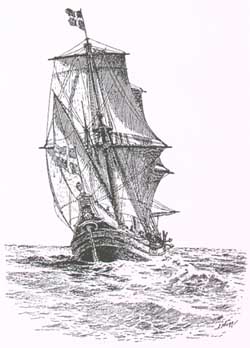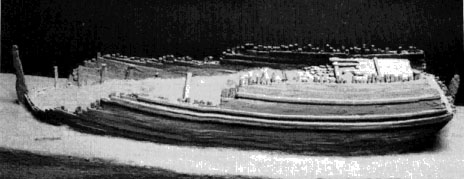The flute ship Anna-Maria
Read the report by Christian Ahström
This ship was built as a flute ship in Amsterdam in 1694. She got Swedish owners and started trading on European ports.
In 1709, she was loaded with planks, iron and copper, headed for Portugal. But the 1708/09 winter was unusually hard, so she had to winter anchored at the Swedish port Dalarö, stuck in the ice. One day, the mate on duty walked across the ice to the local inn, perhaps to get a drink, leaving the galley fire unguarded. The whole ship caught fire and sank through the ice on 20 m depth. The commanding officer, Philip Boivie (Philip Bewe), was sentenced to one week's prison for being responsible. By coincidence that officer was also my relative, of Belgian Vallon ancestry.
 During
the following centuries the ship was forgotten. The 38 m long wreck has been known among scuba divers since
the 1960s, but thought to have been much younger. It was first in the '90s that she was
dendro dated. Following archive research identified her as the Anna-Maria.
During
the following centuries the ship was forgotten. The 38 m long wreck has been known among scuba divers since
the 1960s, but thought to have been much younger. It was first in the '90s that she was
dendro dated. Following archive research identified her as the Anna-Maria.
The wreck is well preserved and the hull in one piece, except for the burned stern. Part of the cargo is still in the hold. I have dived on the site. It was impressive to stand at the bottom and look up at the large bow rising up to deck level.
According to the shipping papers from 1708 she carried this cargo for Lisbon:
- 848 dozens of pine planks
- 46 sheets of copper, weight 1360 kg
- iron bars, weight 116 tons
- steel packed in 136 barrels, total weight 925 kg
In the hold, the planks, copper and barrels have been found. But the iron bars are missing. Either they have rusted away entirely, or they were salvaged. However, large parts of the bottom are covered by an unidentified concretion, which may be remains of oxidised iron.
Unfortunately, recreational diving on the site is now forbidden. The reason seems to be that a few careless divers made damage on the wreck. Now the cautious majority is no longer allowed to see her. Pity. Cultural tourism with minimal impact should be ideal for everybody.
Of the literature cited below, I particularly recommend Looking for Leads, published by the Finnish Academy of Science and Letters, Mariankatu 5, FIN-00170 Helsinki, Finland.
Per Åkesson, October 1998
Sources
- Britt-Marie Petersen: "The Dutch fluitship Anna Maria, foundered in Dalarö harbour in 1709", in International Journal of Nautical Archaeology, vol 16.2 1987.
- Johan Rönnby, Jonathan Adams: Östersjöns sjunkna skepp (Tidens förlag, 1994).
- Christian Ahlström: Looking for Leads, Helsinki 1997
- Christian Ahlström: Spår av hav, yxa och penna (Finska Vetenskaps-societeten, 1995).
- Susanne Rönnby: "Projektet Saltskutan och Anna Maria", in MAT
- Susanne Rönnby: "Projektet Saltskutan och Anna Maria", in MAT 3/93

 Back to Nordic Underwater Archaeology
Back to Nordic Underwater Archaeology